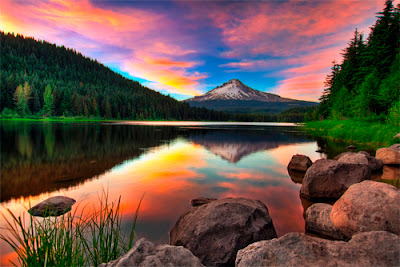Lines are everywhere to be found in nature, and if you pay a little attention to the manner in which they flow across your image you could easily add an entirely different dimension to your photographs. Lines lead the eye of the viewer through the image and they also evoke a sense of motion. Some commonly encountered subjects (lines) while shooting landscapes are winding roads, horizon, trees etc.
While observing a landscape photograph viewers eyes unknowingly search for a horizontal line in the image in order to orient themselves along with the picture. Horizontal lines that fall across the picture like the line created by the horizon, leads the eye of the viewer from one end of the picture to the other and in the process gives emphasis to the objects that fall along the line. In other words viewer’s attention is immediately captured by objects that fall along a horizontal line in the photograph. Such horizontal lines also give the landscape photograph a certain peaceful and familiar feel.
Create a sense of harmony with Horizontal Lines
While observing a landscape photograph viewers eyes unknowingly search for a horizontal line in the image in order to orient themselves along with the picture. Horizontal lines that fall across the picture like the line created by the horizon, leads the eye of the viewer from one end of the picture to the other and in the process gives emphasis to the objects that fall along the line. In other words viewer’s attention is immediately captured by objects that fall along a horizontal line in the photograph. Such horizontal lines also give the landscape photograph a certain peaceful and familiar feel.
 |
| Photo By Patrick Smith |
Create a sense of tension with slanted lines
In landscape photography, diagonal or sloping lines convey uphill and downhill movements and also a sense of action. A slanting line with sharp edges will easily create a sense of discomfort in the mind of a viewer. They not only direct the viewer’s eyes through the photograph but also influence their thoughts.
 |
| Photo By Joshua Cripps |
Convey a sense of perspective and depth using converging lines
Converging lines are lines that come from different parts of the image and meet at a point. They create a sense of depth and perspective to the landscape and make the viewers feel as if they are part of the scene. You should train your eyes to detect the presence of lines in the most unexpected places.
 |
| Photo By Sebastien Mamy |
Convey a sense Motion with vertical lines
In landscape photography, vertical lines convey a sense of dominance and supremacy. They denote strength, solidity, upward growth and power. Vertical lines persuade the eye to move upwards along them to the top of the frame.
 |
| Photo By Ben Heine |
Generate Angular feel with jagged lines
In nature angular lines are mainly formed by flashes of lightning, ridges of mountains or even on the cracked, dry earth. They can make the image look sharp, but they do convey a sense of violent change thereby causing a feeling of discomfort in the mind of the viewer. If used wisely lines can also create rhythmic and symmetrical patterns.
 |
| Photo By Manolis |
Generate Depth with hidden lines
In landscape photography, flat open expanses such as lakes and fields often look like lines when seen from a distance. Such lines can be used to echo the horizon. By using focus one can lend different meaning to them. If you keep the line in focus then they look sharp and straight. But if you render them out of focus or if the lines go in and out of focus along their length in the picture they will create a sense of depth in the photograph.
 |
| Photo By David GN |
While using lines in landscape photography, always explore all options, a single line can be given various interpretations by varying the focal length, trying different compositions, and framing, varying the depth of field and trying out different vantage points from which you click.
In the next article we will discuss about Photography - Landscape Photography - Landscape Photography Techniques